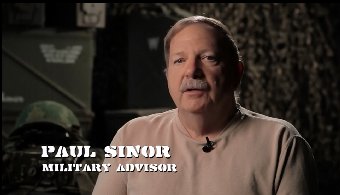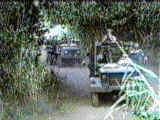Colonel Paul Sinor page 2

(Picture taken from the Fabulous
Films Tour of Duty Documentary)
Answers kindly supplied by Colonel Paul
Sinor who worked on Tour Of Duty
as the shows Technical Advisor.
Questions & Answers page 2
Q/. Can you tell me what the planes in TOD where and was this part of your job to liase between the army and Braun production about what they wanted the planes to do. Also how many helicopters did the production company own/lease ,sometimes there are shots of 4 or more and other times its just two ?
A/. The planes were obtained from the other services as appropriate.
On one occasion I got a Coast Guard C130 when we needed a "jump platform"
for a parachute scene. It was in "Roadrunner?" I think.
We had a man jump from the plane which we did not see, and then follow him to
the ground. He was an injured Air Force pilot.
As for helicopter support, the Production leased one and the remainder came from the
Army. The helicopters, like all military support was provided on a cost basis.

Q/.In the episode
Battling Baker Brothers , the planes look like they swoop
down and drop napalm I believe on a convoy of VC trucks.
As this would have been highly dangerous , how did you set the scene to get the right
explosion ?
A/.The napalm run on the Battling Baker Brothers was one of the most intricately
coordinated scenes I had to do.
The vehicles were obtained from the Army salvage yard then reworked to resemble North
Vietnamese equipment.
Several 55 gallon drums of contaminated fuel was obtained from the Army Engineers and an
Engineer Platoon was given the mission of rigging it for destruction by explosion.
The special effects team TOD headed by Larry Roberts worked with the Engineers to set the
explosions in sequence for the shot.
Several days PRIOR to the fuel and explosives being put into place, I had a flight of
Marine Corps jets like the ones used in Vietnam do several low level passes which were
filmed, and then later the explosives were set off and the editing was done to make it
look like it happened in real time.
Q/. I'm sure that there were times during the filming that things didn't go
exactly to plan, because of the weather, wind or some other natural accurance
Did you have to advise on the spot about anything so that days shooting
didnt have to be stopped ?
A/. Try as I might, I had nothing to do with the weather.
There were several times when we had to film around the weather. The scene did not
call for wind and rain, but it was there and, as they say, the show must go on.
On one occasion, we did have several trucks stuck for several days when it rained so hard
so fast we could not get them out. We finally had to use an Army Tank Retriever to
pull them to a road where they could be driven.

A/. Each day on the set was as different as the episode that was being filmed.
I may be coordinating air support, artillery, showing the guys how to wear or use a particular piece of equipment etc.
The day usually started between 0630-0700 and ended much later. Hardly any
day ended for me and my guys until well after 1900-2000 in the evening.
Q/. In the episode "Sitting Ducks" the guys where introduced to the monks of Vietnam ,where they are attacked everytime they go out on patrol , do you know if this was based on any real events ?
A/. Sitting Ducks was not, to my knowledge based on actual events, however, like
all good fiction, there was some truth in it.
Q/. Before you mentioned the sound stage that was used during the first series , what particular episode parts were filmed there , I know that parts of the tunnel sequences from "notes from the underground" was filmed there , but wondered what others ?
A/. The sound stage held the area that was used as the interior of several rooms
which you saw as offices, bedroom, bars, etc. Unfortunately, I can't give you
specific episode titles.
Q/.During the first few episodes , some of the guys , like Taylor and Johnson refer to Sgt Anderson as Zeke ,this changes during the first series to Sgt Anderson or sarge, any particular reason why that you know of ?
A/. The name change from "Zeke" to Sergeant Anderson was in keeping with
proper military protocol, in that a Private would never refer to his Platoon Sergeant by
his first name.
Q/.You also mentioned that you were "firing live" and there was
no chance of a retake What happened if someone slipped or tripped , were they
just told to carry on as best they could ?
I ask as during "The Siege" I am sure Tony Becker ,(Percell), calls someone by
their real name and then it looks like he slips over as the shot cuts away from him.
A/. Like real life, in the movies or in television, to err is human. We/they
did make mistakes.
Some were caught at the time and some were not. If it could be fixed, it was, it not
and it was dialog that was not terribly important a sound effect could be laid over it.
In one episode, Steve Caffrey slipped and called an Army Medic by the term
"Corpsman" which is a Marine and Navy term. When it was caught prior to
airing, he did what is known as a "sound loop" where he called the man
"Corporal", which in the final cut looked like fine.
There are other mistakes that got through and I'm certain your fans have found them.
If not, I'll be the last to tell.......
CopyrightÓ2021 Craig Blackmore. All rights Reserved.
|
|